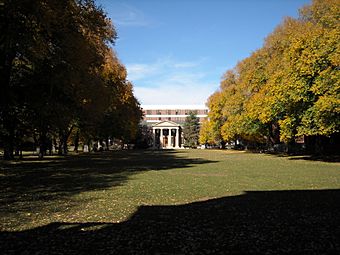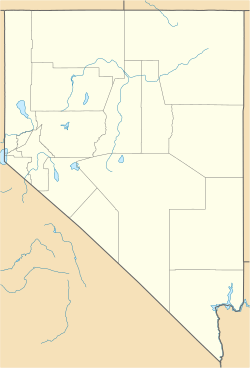University of Nevada Reno Historic District facts for kids
Quick facts for kids |
|
|
University of Nevada Reno Historic District
|
|

University quadrangle
|
|
| Location | Virginia St., Reno, Nevada, U.S. |
|---|---|
| Area | 40 acres (16 ha) |
| Built | 1906 |
| Architect | White, Stanford; Et al. |
| Architectural style | Late 19th and 20th Century Revivals, Second Empire, Jeffersonian Revival |
| NRHP reference No. | 87000135 |
| Added to NRHP | February 25, 1987 |
The University of Nevada Reno Historic District is a special area on the campus of the University of Nevada, Reno. It's like a time capsule, preserving many old and important buildings. This district covers about 40 acres, which is like 30 football fields!
It was officially recognized as a historic district on February 25, 1987. This means it's listed on the National Register of Historic Places. This list helps protect important places in the United States.
Contents
Exploring the Historic District
This district is home to 13 historic buildings. It also includes two other important features. These buildings and features show different styles of architecture. They tell the story of how the university grew over many years.
Famous Architects and Designs
Some very talented architects helped design these buildings. One famous architect was Stanford White. Another was Frederick J. DeLongchamps. Their work makes the district very unique.
The buildings show different architectural styles. These include Late 19th and 20th Century Revivals. You can also see Second Empire and Jeffersonian Revival styles. Each style adds to the district's special look.
Key Buildings and Features
The district includes many buildings that are important to the university's history. Two of these buildings are so special they are listed separately on the National Register of Historic Places. These are the Mackay School of Mines Building and Morrill Hall.
Here are the 13 historic buildings you can find in the district:
- Morrill Hall (built in 1886)
- Lincoln Hall (built in 1896)
- Manzanita Hall (built in 1896)
- Mackay School of Mines (built in 1908)
- Jones Visitors Center (built in 1914)
- Veterinary Building (built in 1914)
- Peter Frandsen Humanities Building (built in 1918)
- Thompson Student Services Center (built in 1920)
- Physical Plant (built in 1921)
- Clark Administration (built in 1927)
- Mackay Science Hall (built in 1930)
- Palmer Engineering Building (built in 1941)
- Gymnasium (built in 1945)
The Gymnasium is especially important to the district. It shows how the university grew and changed over time.
Natural and Open Spaces
Besides the buildings, two other elements are important to the district. These are open spaces that add to its beauty and history.
- University Quadrangle: This is a large, open grassy area. It's often called "The Quad." It's a central gathering place for students.
- Manzanita Lake: This beautiful lake is a peaceful spot on campus. It adds to the natural charm of the historic area.
These features make the University of Nevada Reno Historic District a wonderful place. It's a place where history and learning come together.



